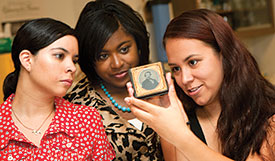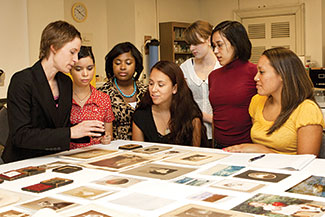
Have boxes of old family photographs in the attic? Here are some tips for preserving your heirlooms for future generations, courtesy of UD's Debra Hess Norris, Henry Francis du Pont Chair in Fine Arts, and Jae Gutierrez, assistant professor of art conservation.

If you're fortunate enough to have 19th-century cased photographs in your family collection, like daguerreotypes, ambrotypes and tintypes, be sure to protect them from high humidity and poor handling. The cases that typically hold these types of photographs can be vulnerable to damage at the hinge that attaches the two halves of a case together. Always handle these photographs with clean, dry hands, and try not to force them open to an entirely flat position. If each half of the case is cradled in one hand and opened to 90 degrees or slightly further, minimal stress will be placed on a case hinge while viewing the image.
Many 19th-century studio portraits, including albumen and collodion photographs, were adhered overall to rigid boards (or mounts) to provide additional support and decorative pre-sentations for photographs. Over time, these boards, or mounts, can become brittle and weaken, and are best handled with care.
The dominant photographic process in the 20th century was black-and-white silver gelatin, until color photography surpassed it in popularity in the 1960s. Many amateur silver gelatin and color photographs were not mounted and have been stored loose in boxes or within family albums. When possible, store your photographs in archival, long-lasting materials. When seeking appropriate storage products for your photographs, look for materials that are advertised as having passed the PAT (Photographic Activity Test). If a product has passed the PAT, it is safe to store your photographs in.
The best storage environments for your photographs are cool and dry spaces that don't experience a lot of extreme temperature or humidity changes. High humidity and high temperatures will cause photographs to deteriorate and should be avoided. Therefore, attics and basements are not good choices for storing your photographs. Interior closets, located near the center of your house, not on an exterior wall, are good storage areas.

In the 21st century, most family images are printed at home. If you are printing your own images, be selective when buying paper and inks. Research has shown that pigment-based inks are more stable than dye-based inks, and therefore will have greater longevity. Images printed on "photo paper" will also have greater longevity than those printed on paper intended for other purposes.